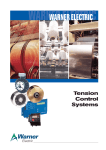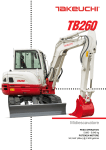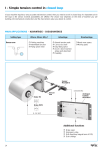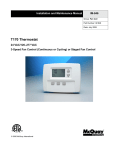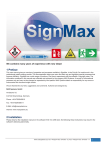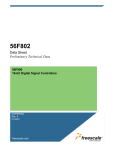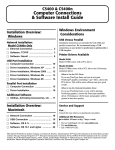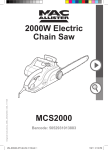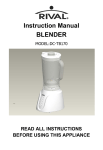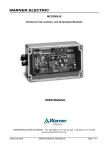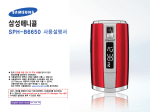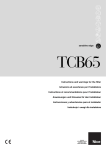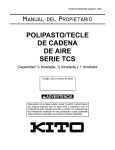Download Magnetic clutches and brakes
Transcript
WARNER ELECTRIC WARNER ELECTRIC Tension Control Systems Max Lamb GmbH & Co. KG Am Bauhof 97076 Würzburg Tel. 0931 / 2794 – 0 Fax. 0931 / 274557 email: [email protected] Tension Control Systems WARNER ELECTRIC offers the most complete product line dedicated to the TENSION CONTROL MARKET. The long experience in the market led us to develop high performance controls able to operate in open and closed loop with brakes. WARNER ELECTRIC electromagnetic brakes find an optimum use in tension control when associated with the new digital control line. ABOUT THIS CATALOGUE This master catalogue groups all the solutions / products that WARNER ELECTRIC offers. An important part is dedicated to the solution design with particular consideration regarding the machine and the tension control installed. This should help you for the right solution choice taking in consideration the results you want to achieve. All the product characteristics and dimensions are included for every product. Applying the appropriated Tension Control will lead you ■ To improve quality of the operation ■ To increase the production ■ Finally to lower your production cost CONTACT WARNER ELECTRIC FOR ANY ASSISTANCE YOU REQUIRE www.warnerelectric-eu.com 2 Index Pages SYSTEM CONFIGURATIONS System configuration 1 System configuration 2 System configuration 3 Open loop solutions Closed loop solutions TENSION CONTROL IN OPEN LOOP I.a I.b II III - Manual setting by pot. - Manual setting by following arm - Automatic setting by diameter reading - Automatic setting by diameter reading with additional functions TENSION CONTROL IN CLOSED LOOP I II III IV - Single roll tension control, automatic setting by dancer arm - Double roll tension control, automatic setting by dancer arm (modular) - Double roll or splicer tension control, automatic setting by dancer arm (compact) - Double roll or splicer tension control, automatic setting by load cells BRAKES AND CLUTCHES RANGE Brakes and clutches models ELECTROMAGNETIC BRAKE TYPE TB 4 4 4 5 6 7 8 8-9 8-9 10-11 12-13 14 14 - 17 18-19 20-21 22-25 26 26 28 Tension brake sizing TB brake characteristics Tension brake for strapping machine 27 28 - 31 32 -33 MAGNETIC PARTICLE CLUTCHES AND BRAKES 34 Design and operation Selection Applications Dimensions and specifications Current regulator power supply for powder brakes MAGNETIC CLUTCHES AND BRAKES Design and operation Applications Dimensions and specifications DATA APPLICATION FORM Material tension data Calculation dates form 34 - 35 36 - 37 38 - 39 40 - 41 42 43 43 44 45 - 50 51 51 52 - 53 3 System configurations Analysing and preparing a project in tension control requires good analysis support. The general block diagrams below are a good representation of any machine generally supporting tension control. We recommend using these diagrams or a part of it in any discussion and correspondence in order to be clear and to avoid possible misunderstandings. The tension area in an unwinding system is defined by places where we want to control this tension SYSTEM CONFIGURATION 1 In single roll unwinding, we have one area tension between A and B. One brake can be easy installed in A. The brake control system selected will be according to the accuracy required: open loop or close loop. ZONE 1*, Typical characteristics (unwind) Zone 1 A B ❐ ❐ ❐ ❐ ❐ ❐ X Tension zone definition: A-B Speed point in B Variable roll rotation speed Variable inertia In general constant tension X Brake system applicable SYSTEM CONFIGURATION 2 Most usual configuration with driving roll,a rewinder and an unwinder.2 separate tension area with tension could be different in X and in Y.Regarding accuracy required we will choice open loop or close loop. In A, unwinding brake, in B motor for the speed and in C clutch or moto-reducer for rewinding. Zone 1 A X 4 B Zone 3 Y Zone 3*, Typical characteristics (rewind) C ❐ ❐ ❐ ❐ ❐ ❐ Tension zone definition B-C Speed point in B Variable roll rotation speed Variable inertia Constant or Taper tension Z Particle brake system applicable System configurations SYSTEM CONFIGURATION 3 More complicated machine with intermediary tension area between winder and unwinder.The intermediary area give the line speed. A master-slave system with speed difference in area B/C give required tension. All tension systems must be according the speed line in close loop. B A Zone 1 X C Zone 2 Zone 3 Y Z IMPORTANT CONSIDERATION D ZONE 2*, Typical characteristics In every machine the speed point location must be clearly identified. In general one of driving nip roll is choose to set the linear speed. The machine speed is considered as MASTER function. The tension control, whatever the selected solution, works in SLAVE mode. Practically, the operator sets the machine speed with a simple potentiometer and all tension control system existing on the machine have to follow, keeping the required tension at any speed and during all transitory speed phases. *NOTE : Each zone is individually controlled. Tension may be different in each zone. It is assumed that there is no slipping on the nip roll. ❐ ❐ ❐ ❐ ❐ ❐ Tension zone definition B-C Speed point in B or C Constant roll rotation speed Constant inertia In general constant tension Y Brake system applicable 5 System configurations OPEN LOOP CONFIGURATION Working in open loop requires an external reference setting applied to the driver. The torque applied to the unwind roll has to vary according to the diameter of the roll. We don’t control acceleration, deceleration and emergency stop as the sensor is blind regarding the band tension. Application needs one sensor only which drives an amplifier without return information for the influence of correction. Sensor Amplifier Brake OPEN LOOP SOLUTION Manual setting by pot. 8 9 Pot. Amplifier Brake Amplifier Brake Amplifier Brake 10 11 Amplifier Brake 12 13 Manual setting by following arm 8 9 Pot. Automatic setting by diameter reading Ultrasonic sensor Automatic setting by diameter reading with additional functions Ultrasonic sensor Additional functions 6 System configurations CLOSED LOOP CONFIGURATION Working in close loop needs one sensor. This one will measure directly or indirectly the band tension. Tension variations detected by sensor are sent to the brake through the control. This action corrects the variation and the new corrected sensor value is sent to the brake and so on. Give a accurate tension regulation during acceleration, deceleration, emergency stop. Sensor Amplifier Brake Position regulation by dancer arm 14 21 This is an electromechanical system and the building quality for the dancer arm must be verified. The band tension is created by the roll weight and/or by pneumatic actuator which have sensible air exhaust. Regulation by load cell 22 23 This is an electromechanical system and the quality of load cells mounting must be checked. The band influences directly the load cells or loads cells. The load cells choice and the mounting are very important regarding overload during starting or emergency stop. Splicer system regulation Our control systems are used with double roll unwinders with splicer. The 2 brakes are always controlled, when one is in regulation, the other has holding function through numeric control range MCS2000. These controls include loop control with PID, a lot of options and are able to be programmed by PC (via RS232 22 23 line) or by external programmer pocket (visual function) A B The PID function is optimised for one inertia value. The MCS2000 line is inclusive of an important feature namely the PID correction. Based on the available diameter information you can apply a continuous PID correction. When no information is available, an internal PID change can be programmed. PID relative values 100% P I 50% D Diam. Info Core Each parameter P, I and D can be set individually for the smallest (core) and biggest diameter. As soon as the correct parameters are found for the extreme diameter value, they are stored. The diameter information provided will fix the PID values for the present diameter value. This will allow the system to keep an excellent stability during the whole diameter evolution. In the case where the diameter information is not available we can provide this signal by installing a sonic sensor or by working with internal correction. The external diameter information supplied to the controller will ensure a better precision compensation compared to an internal correction. Typical PID values for TB brakes 7 I - Tension control in open loop Working in open loop requires that a torque setting is defined. The choice depends on the machine complexity and the automation required. One important factor that remains is the tension precision. For unwind and rewind systems the diameter ratio will play an important role. Working in open loop also requires special considerations regarding system inertia. a b Manual setting by pot. Manual setting by following arm MAIN APPLICATIONS - ADVANTAGE – DISADVANTAGE Setting type By Pot. Where, When, Why ? Advantage ❐ Cable machine ❐ No fast accel/deccel ❐ Low roll diameter ratio ❐ Operator intervention admitted Diameter reading ❐ Low cost solution ❐ Easy to start-up ❐ Automatic regulation by diameter following arm ❐ Manual correction feasible Disadvantage ❐ Tension precision depends on operation ❐ For diameter following arm, accuracy according the roll geometry Amplifier MCS2000-PSDRV 0 - 24 VDC 0 - 10 VDC 100 - 260 VAC Pot. or Brake TB 28 31 Brake MPB 24 VDC 34 41 0 - 24 VDC 0 - 10 VDC Amplifier MCS2000-DRV 8 Manual setting by Pot. Dimensions (mm) 50 ±0,5 6 20,4 15 10 k Ω Linear 0,4 W + 20% 280° +20° 300° ±5 % -25°C to +70°C ø6 mm 10 mm B90-26325C Resistance value Type Power rating at 40°C Tolerance Electric rotation Mechanic rotation Operating temperature Shaft Panel mounting hole Part number 25,2 Pot. 4 1,1 x 0,45 18,2 MCS2000-PSDRV Wiring Setting Mounting position Service manual Power supply / Output voltage / current current 100 – 260 VAC 0-24 VDC/1,4 A Shielded cable Anti-residual Vibrations free, vertically MC517 ELECTRICAL AMPLIFIER MCS2000 75 183 174 165 Electrical input signal 0 – 10 VDC 3,9 Dimensions (mm) ❐ 1 alternative/continue current supply card ❐ 1 logic card with 2 individual channels (1 fixed, 1 with calibration) Model 10 149 ELECTRICAL AMPLIFIER MCS2000-PSDRV 8 60 Dimensions (mm) MCS2000-DRV ❐ 1 logic card with 2 individual channels (1 fixed, 1 with calibration) MCS2000-DRV8 ❐ 1 logic card with 8 individual output channels Power supply / Output voltage / current current 24 VDC/3 A 0-24 VDC/1,4 A 24 VDC/3 A 0-24 VDC/0,3 A per channel Shielded cable Anti-residual Vibrations free, vertically MC517 183 149 MCS2000-DRV MCS2000-DRV8 Wiring Setting Mounting position Service manual Electrical input signal 0 – 10 VDC 0 – 10 VDC 174 165 Model 75 60 9 II - Tension control in open loop MAIN APPLICATIONS - ADVANTAGE – DISADVANTAGE Setting type Diameter reading Where, When, Why ? Advantage ❐ The most commonly used solution in open loop ❐ No operator intervention admitted ❐ Large roll ø ratio ❐ Physical reading, no reset ❐ Easy to start-up Disadvantage ❐ Poor reading accuracy on core Amplifier MCS2000-PSDRV Ultrasonic sensor 0 - 24 VDC 0 - 10 VDC 100 - 260 VAC or Brake TB 24 VDC 28 31 Brake MPB 0 - 24 VDC 0 - 10 VDC 34 41 Amplifier MCS2000-DRV 10 Automatic setting by diameter reading ULTRASONIC SENSORS SCUA-140 SCUA-130 15 to 30 VDC / max 30 mA 100 mm 1000 mm ±1 mm IP67 5 m cable MC487 SCUA-140 15 to 30 VDC / max 30 mA 400 mm 2400 mm ±1 mm IP67 5 m cable MC488 Dimmensions (mm) 23 14,2 ø44,5 65 30° 20 4,3 4,6 60 95 10 5 M12x1 11,2 18,5 15 15 M12x1 31 30 M30x1,5 SCUA-130 SCUA-140 Dimensions (mm) ❐ 1 alternative/continue current supply card ❐ 1 logic card with 2 individual channels (1 fixed, 1 with calibration) MCS2000-PSDRV Wiring Setting Mounting position Service manual ELECTRICAL AMPLIFIER MCS2000 60 Dimensions (mm) MCS2000-DRV ❐ 1 logic card with 2 individual channels (1 fixed, 1 with calibration) Model MCS2000-DRV MCS2000-DRV8 Wiring Setting Mounting position Service manual Electrical input signal 0 – 10 VDC 0 – 10 VDC Power supply / Output voltage / current current 24 VDC/3 A 0-24 VDC/1,4 A 24 VDC/3 A 0-24 VDC/0,3 A per channel Shielded cable Anti-residual Vibrations free, vertically MC517 75 174 165 MCS2000-DRV8 ❐ 1 logic card with 8 individual output channels 149 Power supply / Output voltage / current current 100 – 260 VAC 0-24 VDC/1,4 A Shielded cable Anti-residual Vibrations free, vertically MC517 183 174 165 Electrical input signal 0 – 10 VDC 75 183 149 ELECTRICAL AMPLIFIER MCS2000-PSDRV Model 70 SCUA-130 Model Power supply Min. distance Max. distance Accuracy Protection class Accessory Service manual 60 11 III - Tension control in open loop MAIN APPLICATIONS - ADVANTAGE – DISADVANTAGE Setting type Diameter reading Where, When, Why ? Advantage ❐ The most commonly used solution in open loop ❐ Operator intervention admitted ❐ Large roll ø ratio Disadvantage ❐ Physical reading, ❐ Poor reading no reset accuracy on core ❐ Easy to start-up ❐ Graphic display for output percentage value ❐ Functions control available remote/manually by operator MCS2000-POT OPTION for MCS2000-DRV : MCS2000-PS Power supply +24VDC Ultrasonic sensor Ultrasonic sensor signal 0 - 10 VDC Amplifier MCS2000-PSDRV 0 - 10 VDC 0 - 24 VDC Brake TB 100 - 260 VAC 28 31 Brake MPB or 34 41 Amplifier MCS2000-DRV 0 - 10 VDC 0 - 24 VDC Additional control signals 24 VCC 12 Fast Stop, Hold Brake OFF Automatic setting by diameter reading Ultrasonic sensors - Dimensions, see page 7 SCUA-130 Model Power supply Min. distance Max. distance Accuracy Protection class Accessory Service manual SCUA-140 SCUA-130 15 to 30 VDC / max 30 mA 100 mm 1000 mm ±1 mm IP67 5 m cable MC487 SCUA-140 15 to 30 VDC / max 30 mA 400 mm 2400 mm ±1 mm IP67 5 m cable MC488 Ultrasonic Diameter Sensing – MCS2000-POT ❐ A simple, analogue, open loop torque control. ❐ Power supply 24 VDC / Internal consumption 150 mA. ❐ Adjustable maximum level of the output signal relatively to the ultrasonic input level. ❐ Graphic display of the output level – full screen equal 10 VDC. ❐ FAST STOP, HOLD and BRAKE OFF can be activated either through the front switches or through the terminal bloc. ❐ FAST STOP and HOLD levels are adjustable via potentiometer. ❐ FAST STOP: a ratio of 1 to 10 times to OPERATING LEVEL ❐ OPERATING LEVEL: maximum 10 VDC divided by the FAST STOP ratio. ❐ HOLD: output level adjustable between 0 and 10 VDC To be used ONLY with scalable ultrasonic sensors type SCUA-130 (1 m) or SCUA-140 (2.5 m) Mounting and dimensions (mm) Overall dimensions maximum: Height 160 mm Width 95 mm Depth 75 mm Weight 0,350 kg ❐ Service manual : MC520 ELECTRICAL AMPLIFIER MCS2000 MCS2000-PSDRV MCS2000-DRV MCS2000-DRV8 Wiring Setting Mounting position Service manual Electrical input signal 0 – 10 VDC 0 – 10 VDC 0 – 10 VDC Power supply / Output voltage / current current 100 – 260 VAC 0-24 VDC/1,4 A 24 VDC/3 A 0-24 VDC/1,4 A 24 VDC/3 A 0-24 VDC/0,3 A per channel Shielded cable Anti-residual Vibrations free, vertically MC517 MCS2000-DRV8 ❐ 1 logic card with 8 individual output channels Dimensions (mm) 75 183 149 Model MCS2000-DRV ❐ 1 logic card with 8 individual output channels 174 165 MCS2000-PSDRV ❐ 1 alternative/continue current supply card ❐ 1 logic card with 2 individual channels (1 fixed, 1 with calibration) 60 13 I - Simple tension control in closed loop If your machine requires a very accurate web tension control, then you need to work in closed loop. An important unit in the loop is the sensor. Several possibilities are offered. The choice now depends on the kind of machine you are building, the mechanical construction and the max tension value you desire to control. MAIN APPLICATIONS - ADVANTAGE – DISADVANTAGE Setting type Dancer arm Where, When, Why ? ❐ Printing machines ❐ Intermittent function ❐ Flying splice need Advantage ❐ Absorb tension peak ❐ Can act as store ❐ Easy flying splice ❐ Accel / decel machine phase well absorbed ❐ Flexibility Disadvantage ❐ Need more space ❐ Moving parts Sensor MCS605-E 110/230 VAC Dancer arm Analogue Control MCS202-E Brake TB 28 31 Brake MPB 34 41 0 - 24 VDC Additional functions ❐ ❐ ❐ ❐ 14 Brake open Emergency stop Drift stop(stop integral term of PID) Gain change Automatic setting by dancer arm ROTARY SENSOR MCS605-E (see pages 16 and 17) ANALOGUE CONTROL MCS202-E ❐ MCS202-E1 Standard execution ❐ MCS202-E54 Standard IP54 protected ❐ MCS202-EC1 Open frame execution Technical characteristics – valid for 3 executions Range - Values 110-220 VAC selectable Max 2, 5 Amps, short circuit protected Loop gain Offset torque 0-24 VDC Metal rugged housing 2 adjustable range selection MCS-KIT1, 2, 3, 5 and 6 Dancer arm with MCS605-E MC403 Power supply Output current capability User settings Output voltage brakes Housing Loop gain Accessories Sensor compatible Service manual Comments Open front face to access Able to power 2 TB in parallel Front face potentiometer Front face potentiometer Compatible all elec. Warner Electric Only MCS202-E1 and –E54 Can be change during operation See details on page 17 See details on pages 16 and 17 Technical information MCS202 control is based on classical and fixed PID terms. The loop gain can be set on front face potentiometer. Due to the fixed PID terms, its use is limited in terms of roll diameter ratio. One input is provided to change the loop gain and has to be used when diameter ratio exceeds 8. To ensure proper operation it is important to wire the function “Drift Stop”. This function releases the Integral term as soon as the machine runs. 99 37 29 Dimensions (mm) 51,5 73 60 87 282 265 MCS 202-E LOOP GAIN 14,3 BRAKE TORQUE OFFSET ø65 57 120 POWER 15 Automatic setting by dancer arm ROTARY SENSOR MCS605-E A position sensor is used in 2 possible ways: ❒ - To detect dancer moving in the closed loop installation working on dancer principle. ❒ To sense the diameter of the roll to operate open loop control or make PID compensation in closed loop installation. Power supply Max. detection angle Sensitivity Service manual MCS605-E 10 to 30 VDC / 30 mA (or ± 5 to 15 VDC) 200° or ± 100° 2,5 mV / V / ° MC483 ELECTRICAL CONNECTIONS CONNECTOR CABLE – Supply White 3 +15 V 2 Green Signal 4 + Supply Brown -15 V 1 Shield Signal View from outside Sensor Working in closed loop with the arm dancer principle is very popular especially in the printing market where a good flexibility of the system is required to absorb the eventual “tension peaks”. The rotary sensor is necessary to read the dancing roll movement. MCS605-E is ideal for easy mounting. It is encapsulated in rugged metal housing preventing mechanical shocks. Furthermore it is provided with built in switch in order to change the signal output polarity. TB brake 16 Automatic setting by dancer arm MCS605-E ACCESSORIES The MCS202-Exx is designed to work with dancer arm principle. Usually the sensor is a rotary type. Warner Electric sensor MCS605-E are delivered with complete mounting kit. Mounting kit comprises of CABLE, COUPLING, BRAKETS and all necessary SCREWS. Various KITS have various lengths of cable and cable with or without connector at control end side. MCS2000 line requires free leads (MCS2000 control line is provided with terminal block). MCS202-Exx requires a connector (MCS202-Exx is provided with the connector). Cable length 3m 3m 4,5 m 4,5 m 6m 8m MCS-KIT1 MCS-KIT2 MCS-KIT3 MCS-KIT4 MCS-KIT7 MCS-KIT8 One / Two connectors 2 1 2 1 2 1 Compatible MCS202-Exx MCS2000 MCS202-Exx MCS2000 MCS202-Exx MCS2000 Dimensions (mm) – Mounting 130 50,8 min 47 / max 70 18 57 ø6,35 65 Coupling 3x1 20° 57 31,6 ø38,1 45 14,2 38,1 21,9 ø6,5 3 x ø45 17 II - Double tension control in closed loop (modular) MCS2000-ECA is a digital controller that can be used in both open or closed loop. Operation in open and closed loop is also possible. It is mainly destined for OEM application. The programming tool is detachable. Sensor, sensor mounting kit, display are available as options. The unit has to be powered with 24 VDC. MAIN APPLICATIONS - ADVANTAGE – DISADVANTAGE Setting type Dancer arm Where, When, Why ? ❐ Printing machines ❐ Intermittent function ❐ Flying splice need Advantage ❐ Absorb tension peak ❐ Can act as store ❐ Easy flying splice ❐ Accel / decel machine phase well absorbed ❐ Flexibility Disadvantage ❐ Need more space ❐ Moving parts Sensor MCS605-E 16 17 Dancer arm Brake TB Memory card MCS2000-CRD-2 28 31 Amplifier MCS2000-PSDRV Brake MPB 11 34 41 Controller MCS2000-ECA 100 - 260 VAC 0 - 10 VDC or Hand Programmer MCS2000-PRG Amplifier MCS2000-DRV 24 VDC 18 11 MCS2000-WIN programme Automatic setting by dancer arm ELECTRICAL AMPLIFIERS MCS2000-PSDRV and MCS2000-DRV (see page 9) ROTARY SENSOR MCS605-E (see pages 16 et 17) CONTROLLER MCS2000-ECA ❐ Digital controller - 2 channels Main Characteristics ❐ ❐ ❐ ❐ ❐ ❐ ❐ ❐ ❐ ❐ ❐ ❐ 24 VDC power supply unit PID parameters setting on line Automatic adaptation for PID parameters, splicing logic included Opto isolation for input and output Compatible PLC Automatic sensor scaling and output sensor information Programming easy by pocket keyboard or PC(Windows) Available in open loop as calculator 2 analogic input, 2 output channels Plugable memory card Three language available Most dedicated for unwinding and rewinding with electromagnetic brakes and clutches. ❐ Service manual : MC514 MCS2000-PRG - HAND PROGRAMMER ❐ ❐ ❐ ❐ ❐ 4 command keys only 2 x 16 characters display Menu in 3 languages Connectable and disconnectable during operation Supply by control MCS 2000-EC MCS2000-CRD-2 - MEMORY CARD All setting data saved. It allows a quick loading operation on new machine or on running machine to optimise. ❐ Memory for 2 different programs ❐ Plugable on line in MCS2000-ECA unit MCS2000-WIN – PROGRAMME The program can modify the running setting by this software running with: Windows 95/98/XP/2000. 19 III - Double tension control in closed loop (compact) The command unit MCS2000-CTDA is a complete solution with power supply and programmer display integrated. There are 2 software version available. See technical data below MAIN APPLICATIONS - ADVANTAGE – DISADVANTAGE Setting type Dancer arm Where, When, Why ? ❐ Printing machines ❐ Intermittent function ❐ Flying splice need Advantage ❐ Absorb tension peak ❐ Can act as store ❐ Easy flying splice ❐ Accel / decel machine phase well absorbed ❐ Flexibility Disadvantage ❐ Need more space ❐ Moving parts Sensor MCS605-E 16 17 Dancer arm Brake TB Memory card MCS2000-CRD-2 28 31 Amplifier MCS2000-PSDRV Brake MPB 11 34 41 Controller MCS2000-CTDA 100 - 260 VAC 0 - 10 VDC or Amplifier MCS2000-DRV 24 VDC 20 11 MCS2000-WIN programme Automatic setting by dancer arm ELECTRICAL AMPLIFIERS MCS2000-PSDRV and MCS2000-DRV (see page 9) ROTARY SENSOR MCS605-E (see pages 16 et 17) CONTROLLER MCS2000-CTDA Specifications Input power supply 110-240 VAC selectable Analogue inputs Two analogue inputs 0-10 VDC Analogue outputs Two controlled channels Open loop signal ± 10 VDC, 0-20 mA 0-10 VDC Digital inputs Set point change + Set point change – Set point change ± active low active low front face switch Gain multiplier Output limitation ABC binary combination ABC inputs synchronisation Stop integral form active low active low active low active low active low Digital outputs Sensor level indication Two binary outputs Main features ❐ ❐ ❐ ❐ ❐ ❐ ❐ ❐ ❐ ❐ ❐ ❐ ❐ ❐ Three mounting possibilities Software password protected Scrolling menu program Multipurpose application RS232 communication Two ouput channels Automatic sensor scaling Programmable output configuration Output sensor information External set point change Automatic or imposed PID correction All features requested for tension control Plugable memory card Variable tension value to prevent telescopic effect on unwinding – CTDA-22 ❐ Service manual : MC525 Other outputs Power supply sensor Power supply Voltage reference ± 15 VDC / 100 mA ± 5 VDC / 100 mA 24 VDC + 10 VDC / 10 mA MCS2000-CRD-2 - MEMORY CARD All setting data saved. It allows a quick loading operation on new machine or on running machine to optimise. ❐ Memory for 2 different programs ❐ Plugable on line in MCS2000-ECA unit MCS2000-WIN – PROGRAMME The program can modify the running setting by this software running with: Windows 95/98/XP/2000. 21 IV - Double tension control in closed loop The command unit MCS2000-CTLC is a complete solution with power supply and programmer display integrated. There are 2 software version available. See technical data below MAIN APPLICATIONS - ADVANTAGE – DISADVANTAGE Setting type Load cell Where, When, Why ? ❐ Slitter, Sheeter Coater ❐ For heavy material ❐ Limited room ❐ No fast accel/decel ❐ Tension peak accepted Advantage ❐ Direct tension measure ❐ Mechanically well integrated ❐ No moving part Disadvantage ❐ No tension peak absorption ❐ Accel/decel machine not easy to manage ❐ Flying splice function not easy One or two load cells Memory card MCS2000-CRD-2 Amplifier MCS2000-PSDRV Brake TB 11 28 31 Controller MCS2000-CTLC Brake MPB 34 41 100 - 260 VAC 0 - 10 VDC or Amplifier MCS2000-DRV 0 - 24 VDC 11 0 - 24 VDC 24 VDC 22 MCS2000-WIN Programme Automatic setting by load cell ELECTRICAL AMPLIFIERS MCS2000-PSDRV and MCS2000-DRV (see page 9) CONTROLLER MCS-2000-CTLC Specifications Input power supply 110-240 VAC selectable Analogue inputs Two analogue inputs 0-10 VDC Analogue outputs Two controlled channels Open loop signal ± 10 VDC, 0-20 mA 0-10 VDC Digital inputs Set point change + Set point change – Set point change ± active low active low front face switch Gain multiplier Output limitation ABC binary combination ABC inputs synchronisation Stop integral form active low active low active low active low active low Digital outputs Sensor level indication Two binary outputs Main features ❐ ❐ ❐ ❐ ❐ ❐ ❐ ❐ ❐ ❐ ❐ ❐ ❐ ❐ Three mounting possibilities Software password protected Scrolling menu program Multipurpose application RS232 communication Two ouput channels Automatic sensor scaling Programmable output configuration Output sensor information External set point change Automatic or imposed PID correction All features requested for tension control Plugable memory card Service manual : MC525 Other outputs Power supply sensor Power supply Voltage reference ± 15 VDC / 100 mA ± 5 VDC / 100 mA 24 VDC + 10 VDC / 10 mA MCS2000-CRD-2 - MEMORY CARD All setting data saved. It allows a quick loading operation on new machine or on running machine to optimise. ❐ Memory for 2 different programs ❐ Plugable on line in MCS2000-ECA unit MCS2000-WIN – PROGRAMME The program can modify the running setting by this software running with: Windows 95/98/XP/2000. 23 Load cells The FOOT MOUNTED LOAD CELL is the ideal solution to retrofit machines or for heavy tension measurement. The foot mounted model has to be installed with a pillow block type ball bearing supporting the sensing shaft. FM01A... and FM02-... are only differenciated by the physical dimensions. FOOT MOUNTED TYPE FM01A… and FM02-… Foot mounted load cells are available in two versions: With incorporated amplifier : FM……..-AC AC = amplifier and connector on the load cell body Without amplifier : FM……..-C C = connector on load cell body Specifications (all FM series) Power supply Sensitivity Rating Connections Permitted overload - Compression - Extension Radial permitted force Dimensions Mounting Service manual FM……..-AC FM……..-C ±12 to ±15 VDC ± 5 VCC or +10 VDC 0-5 VDC, nominal load 10 mV, nominal load 100 – 250 – 500 – 1000 – 2500 – 5000 – 10000 N Cable supplied 150 % 120 % 50% See mounting instructions ref. MC480 See recommendations on page 25 MC480 AVAILABLE MODELS / CAPACITY Nominal load 100 N 250 N 500 N 1000 N 2500 N 5000 N 10000 N FM01AFM01AFM02..FM02..- -100-AC -100-C -250-AC -250-C -500-AC -500-C -1000-AC -1000-C -2500-AC -2500-C -5000-AC -5000-C -5000-AC -5000-C -10000-AC -10000-C 24 Load cells END SHAFT LOAD CELLS are normally used in new machines designed with the possibility to place the load cell directly on the sensing roll. The end shaft version offers the advantage of being able to easily place the load cell in any tension resultant direction. The ES model exists in two versions differenciated with the diameter of ball bearing which has to be placed in. All end shaft load cells are based on the Wheatstone bridge principle. They have no built in amplifier. They are delivering a signal which is proportionnal to the voltage supply and tension applied. It is important to respect the measurement direction referenced on the load cell body (normally an arrow indicates the sensitive direction). ES..-... LOAD CELL FEATURES Power supply Sensitivity Rating Connections Mechanical overload Dimensions Mounting Service manual ES01-40C and ES02-52C 10 to 15 VDC / 40 mA (±5 VDC in Warner Electric control) 2 mV / V supply at nominal load 1 mV / V supply for 50 and 150 N models 50-150-250-500-1000-2000 N 5 m shielded cable supplied Max 150 % in any direction See mounting instructions ref. MC481 and MC482 See recommendations below MC481 and MC482 AVAILABLE MODELS / CAPACITY Nominal load 50 N 150 N 250 N 500 N 1000 N 2000 N ES01-... ES02-... -50-40C - -150-40C - -250-40C -250-52C -500-40C -500-52C -1000-40C -1000-52C -2000-40C -2000-52C LOAD CELLS SIZING - MOUNTING RECOMMENDATIONS Please keep this principle in mind: the load cell installed is destined to measure the WEB TENSION and not other constraints applied to it. Wrapping Angle 240° min. Take the following points into consideration before selecting, sizing and installing material components. ❐ Load cells location should be vibration free. Vibrations will decrease quality measurement. ❐ The sensing shaft fitted on or in has to be very well balanced. Unbalanced shaft will create measurement oscillation, causing variations in control quality. ❐ Adapted ball bearing have to be used to avoid original stress on load cell (self-aligning ball bearing). ❐ Respect a reasonable sensing shaft weight/web tension measure ratio. Less than 1. ❐ Do not oversize the load cell respect to your calculation. Max admitted factor 3, recommended 1,5. ❐ Respect a minimum wrapping angle on load cell. Min = 240°. ❐ So far as it is possible, use load cell in compression, with web tension effect in same direction as the weight of shaft. 25 Tension brakes and clutches range Brake and clutch types Series Main characteristics Torque range Electromagnetic brakes TB Monodisc 24 VDC power supply 0,5 - 300 Nm Size 170 260 425 500 Electromagnetic brakes 825 1000 1225 1525 28 31 Monodisc 24 VDC power supply TBM Size 10 Pages 10 Nm 32 33 Magnetic particle brakes Magnetic particle clutches Permanent magnetic brakes MPB Size 2 15 70 120 240 Completely packaged and enclosed unit Shaft output 24 or 90 VDC power supply 0,04 - 27 Nm MPC Size 2 15 70 120 Completely packaged and enclosed unit Both end shaft output 24 or 90 VDC power supply 0,04 - 13,2 Nm MB Completely packaged and enclosed unit Shaft output Manual setting 0 - 33 Nm Completely packaged and enclosed unit Bore output Manual setting 0,07 Ncm - 33 Nm Size 1 1,5 2 3 4 Permanent magnetic clutches MC Size 1,5 2 3 4 26 5 5,5 6 9 5 5,5 6 9 34 41 34 42 43 50 43 50 Tension brake sizing Two important parameters are used in brake selecting: ❐ Max. torque requirement ❐ Max. thermal power to be dissipated These two values are determined by the application (see calculation example on pages 52-53). ELECTROMAGNETIC BRAKE TYPE TB – SELECTION TB brake selection is based on two values : Max torque need (Nm) on the brake *Max brake rotation speed for the max torque (rpm) * As the curve given for TB selection takes the power dissipation into account, this value is used. Tmax = torque needed at the brake for the max tension in material and the max roll diameter taking any gear ratios into account. Tmax Selection point Nmax = brake rotation speed for the max linear speed and the max roll diameter – taking any gear ratios into account. N max Note : the constant tension in the web gives a constant power on the brake. However, we make the selection for the max torque (then at full roll diameter) because it’s the moment where the brake has the least natural cooling. Gear box Speed Brake Torque 27 TB brake selection The table (pictured below left) illustrates the selection of the correct TB brake. The table on the right determines the maximum torque provided by the brake when nominal voltage is applied. After selection you can consult the complete brake characteristics and dimensions on pages 30 to 31. Dynamic braking torque TB170 - TB1525 400 500 300 400 TB 15 200 300 TB 122 TB TB 10 00 60 TB 825 40 30 TB 500 20 150 Brake torque MB [Nm] 25 25 12 TB 1000 200 15 TB 100 80 25 5 150 Torque Md [Nm] Maximum braking torque (emergency stop) TB170 - TB1525 100 80 TB 825 60 50 40 TB 500 30 15 10 20 8 15 TB 425 TB 425 6 10 4 8 3 6 5 2 1,5 TB 260 4 TB 260 3 1 0,8 2 0,6 0,4 1 TB 170 0,3 0,6 0,2 10 20 15 40 30 60 100 200 400 50 80 150 300 500 Brake n (rpm) 28 TB 170 0,8 0 100 200 300 Brake n (rpm) 400 500 TB brake characteristics TB units are assembled using various parts described below. Main components of the brake are armature and magnet. Additional parts are offered to provide for ease of mounting. Part 1 2 Armature hub* Armature 3 Magnet 24V 4 Terminals TB170 TB260 TB425 D = 46 mm B5102-541-001-38 K110-0096 K375-631-012 R = 110 Ω, 20°C Wires D = 69 mm B5103-541-001-47 K110-0097 K5365-631-016 R = 60 Ω, 20°C B5103-101-002 D = 111 mm B5104-541-001-31 K110-0098 K5367-631-008 R = 76 Ω, 20°C B5103-101-002 1 2 3 4 5 5-1 6 7 * Prebored ** Indicate bore and keyway Part Part D = 130 mm Taperlock bushing** B180-xxxx-xxxx Armature hub K5300-541-004 Armature B110-0047 K5300-101-003 Drive pins 3x Magnet IM 24V B5300-631-040 Terminals B5311-101-001 Magnet OM 24V B5300-631-000-46 Conduit box K5200-101-010 TB825 TB1000 TB1225 TB1525 D = 259 mm B180-xxxx-xxxx B540-0313 B5302-111-021 B5301-101-001 3x B5312-631-000-36 R = 20 Ω, 20°C B5311-101-001 - D = 316 mm B180-xxxx-xxxx B540-0015 B5303-111-011 B5301-101-001 4x B5313-631-000-11 R = 22 Ω, 20°C B5311-101-001 - D = 395 mm B180-xxxx-xxxx B540-0314 B5304-111-005-04 B5301-101-001 4x B5314-631-000-08 R = 20 Ω, 20°C B5311-101-001 - K5200-101-011 K5200-101-011 K5200-101-011 1 2 3 Taperlock bushing** Armature hub Armature 4 Drive pins 4 Magnet IM 24V 5-1 6 Terminals Magnet OM 24V D = 215 mm B180-xxxx-xxxx B540-0394 B5301-111-019 B5301-101-001 3x B5311-631-000-30 R = 20 Ω, 20°C B5311-101-001 B5311-631-000-16 7 Conduit box K5200-101-011 TB500 29 TB brake characteristics All TB brakes are rated at 24 VDC nominal. When selection is correct the voltage on the brake should be approximately 12 VDC for your maximum parameters used in calculation. All TB brakes are able to work for short periods of time (less than 10 seconds) in the 12-24 VDC range, for example in machine deceleration or in emergency stop. Technical data and dimensions TB170, TB260, TB425 TB500 IM TB825 IM, TB1000 IM, TB1225 IM B A C 1,6 øG øD øH øM øL 2,4 K 3,2 øS øQ øS øQ øG K øN øP øD øM øL 3,2 øN øG øS øQ K øD øH øL E øP B ø9,52 ±0,025 3,0 E 0,4 A T B C A TB500 OM Size Md Md min n max I 24V = P* Continu P* Alternativ R 20° C tb Inertia Mass A B C øD E [Nm] [Nm] [rpm] [A] [kW] [kW] [Ω] [s] [kgm2] [kg] [mm] [mm] [mm] [mm] [mm] TB825 OM, TB1000 OM, TB1225 OM TB170 TB260 TB425 TB500 TB825 TB1000 TB1225 TB1525 0,8 0 5000 0,22 0,015 0,022 110 0,020 12 • 10-6 0,180 30,5 7 46 20,6 4 0,08 5000 0,40 0,030 0,045 60 0,040 116 • 10-6 0,650 48,5 12 69 32 16,5 0,16 5000 0,32 0,060 0,100 76 0,080 1,4 • 10-3 1,800 52 14 111 30,5 35 0,2 5000 1,010 0,100 0,180 23,8 0,052 1,9 • 10-3 2,3 79 77 51 130 30,5 75 0,5 3000 1,177 0,200 0,360 20,4 0,112 0,022 8,2 94 30,5 54 215 33,5 150 1,1 2400 1,224 0,360 0,650 19,6 0,152 0,041 12 105 30,5 56,5 259 36,5 300 2 2000 1,076 0,520 0,950 22,3 0,290 0,095 21 138 30,5 62 316 41,5 450 3 1600 1,212 0,810 1,580 19,8 0,310 0,213 27,5 116 30,5 65 395 44,5 * Alternativ duty based on 30 minutes ON and 30 minutes OFF. 30 E F 1,2 TB brake characteristics TB825 - 1525 øG øN øP 2,4 10 9,5 K øU 30 661-0005 ø12,7 E C A F øG øH K* øL max [mm] [mm] [mm] [mm] [mm] øM±0,025 [mm] øN±0,05 [mm] øP (for screw) [mm] øQ-0,05 [mm] øS (for screw) [mm] T øU [mm] [mm] +0.01 -0 3,5 Size Steel < 0,2 % C M øD øM øH øL B ø12,7 +0.025 0 1/2 -13 UNC-3B TB1525 IM Non magnetic 15 TB170 TB260 TB425 TB500 TB825 TB1000 TB1225 TB1525 19,5+0,05 15,9 10,3 10 - 35 30,1 17,5 20 - 62 31,8 22,2 22 - 61,9 54 4 × M4 - 88,9 79,4 4 × M4 - 142,47 127 4 × M6 - 28,5 49 38 32 98,42 3 × 120° 52,40 60,3 8 × M4 165,10 149,2 4 × M10 49 110 55 118 38 42 90,49 3 × 120° 88,93 108 6 × M8 247,62 255,5 4 × M8 170 98 159 44,5 60 133,4 3 × 120° 136,55 155,6 6 × M8 220 114 175 76 75 149,3 4 × 90° 161,95 184,1 6 × M8 260 180 152,5 76 75 215,9 4× 90° 228,60 247,60 12 × M8 340 * Reverse mounting of taperlock bushing is possible 31 Tension brake for strapping machine Specially designed for strapping machine, the electromagnetic brake TBM10 is adjustable for the different kind of plastic film. Mounted on the intermediate roller, it will tighten the plastic film and will permit a perfect strapping. TBM BRAKE PALLET PLASTIC FILM ROLLER TBM SIZE 10 Brake torque 8 M d (Nm) M d (Nm) Heat dissipation torque 6 4 3 15 10 8 2 6 5 1.5 4 1 3 10 20 15 40 60 100 200 400 30 50 80 150 300 500 n (rpm) 32 20 0 100 200 300 400 500 n (rpm) Tension brake for strapping machine TBM SIZE 10 VAR 03 ➀ T T 500 ➁ 45° P9 ø 90 ø 100 h9 ø 42 ø 5.5 D H8 ø 81 ➂ 4.5 26 D min = 8 mm with standard keyway D min = 13 mm with standard keyway 3 pins on ø 57.96 7.9 H8 VAR 04 8.3 ➃ T T ➀ ø 41 ø 0,10 U max : 24 VDC - P 20°C = 10,8 Watts 26 1 2 3 Keway according to : ISO R773 / BS 4235 / NFE 22175 / tolerance P9 4 Part TBM TAILLE 10 Inductor 24VDC Armature VAR03 Hub prebored ø7,5 Hub ø12 H8 + Keyway 4 P9 Armature VAR04 B6650-631-000-39 B110-0000-1358 B540-0000-2519 B540-0000-2517 B6650-111-000-08 33 Magnetic particle clutches and brakes Accurate torque control with instantaneous engagement! Warner Electric Precision Tork™ magnetic particle clutches and brakes are unique because of the wide operating torque range available. Torque to current is almost linear and can be controlled very accurately. The unique features of the magnetic particle clutches and brakes make them ideal for : ❐ ❐ ❐ ❐ tension control load simulation cycling/indexing soft starts and stops Specials are our business Special Shaft Configurations ❐ Customer specified shaft configurations for easy machine mounting and retrofitting. Wash Down Environment ❐ Stainless steel units available for extreme environments. Special Torque ❐ Maximum torque configurations to meet customer specifications. Metric units ❐ On request, regarding quantities 34 Features and Benefits Torque independent of slip speed ❐ Torque is transmitted through magnetic particle chains which are formed by an electromagnetic field. The torque is independent of slip speed, depending only on circuit current, and is infinitely variable from 0 (disengaged) to rated torque. Precise engagement ❐ Precision Tork magnetic particle clutches and brakes engage to transmit torque with speed and precision. Response of the particles to the field is virtually instantaneous, providing perfectly controlled, jerk-free engagement. Customer specified engagement ❐ Engagement time may be very gradual or extremely fast. The frequency and torque of the engagement/disengagement sequence is limited only by the capabilities of the control circuitry. No wearing parts ❐ There are no friction surfaces to grab or wear, and the units are not affected by changes in atmospheric or other environmental conditions. Efficient/Compact design ❐ High torque to size ratio and low consumption of electric power. Versatile mounting ❐ Convenient bolt circle for easy mounting. ❐ Mounting brackets available for all sizes. ❐ Brakes are available with solid shafts and through bore. ❐ Can be mounted horizontally or vertically to solve virtually any motion control requirement. Modular ❐ Customised products ❐ Interchangeable with industry standard sizes Design and operation Completely packaged and enclosed unit. Easy to install Stainless steel hardware Low current coil generates magnetic field Extremely long life spherical magnetic particles Zinc dichromate plating on all steel surfaces Magnetic powder cavity Stainless steel input shaft Convenient pilot and mounting bolt pattern New and unique dual seal design Operating Principles The magnetic particle unit consists of four main components: 1) Housing 2) Shaft/disc 3) Coil 4) Magnetic powder Engagement When DC current is applied to the magnetic particle unit, a magnetic flux (chain) is formed, linking the shaft/disc to the housing. As the current is increased the magnetic flux becomes stronger, increasing the torque. The magnetic flux creates extremely smooth torque and virtually no “stick-slip”. Torque current curve 120 Percent of rated torque The coil is assembled inside the housing. The shaft/disc fits inside the housing/coil assembly with an air gap between the two; the air gap is filled with fine magnetic powder. 100 80 60 Power input (DC) Stationary field Magnetic-flux path Magnetic particles Rotor Cylinder Seal Output shaft Input shaft Field coil 40 Disengagement 20 0 0 20 40 60 80 100 Percent of rated current 120 When DC current is removed the magnetic powder is free to move within the cavity, allowing the input shaft to rotate freely. 35 Magnetic particle clutches and brakes Selection Sizing To properly size magnetic particle clutches or brakes the thermal energy (slip watts) and torque transmitted must be considered. If thermal energy and torque are known for the application, select the unit from the charts to the right. Speed V (RPM)* = Velocity (m/min) π · ø coil** (m) * In rewind applications the motor RPM should be higher (10%) than the fastest spool RPM. ** In applications with the web running over a pulley or in a nip roll application use the pulley diameter as the roll diameter. Thermal Energy (slip watts) 1- When a brake or clutch is slipping, heat is generated. Heat is described in terms of “energy rate” and is a function of speed, inertia, and cycle rate. For continuous slip applications, such as tension control in an unwind or rewind application slip watts are calculated using the following formula: Slip Watts = 0,103 · torque (Nm) · speed (RPM) 2- For cycling applications heat is generated intermittently, and is calculated using the following formula: Slip Watts = 0,00077 · J (kgm2) · speed (RPM)2 10000 · f cycle min The average heat input must be below the clutch or brake’s heat dissipation rating. If the application generates intermittent heat dissipation, use the average speed for the thermal energy (slip watts) calculations. Torque 1- Tension applications calculate torque as a function of roll radius and tension. C (Nm) = T (N) · D 2 2- Soft/controlled stopping applications calculate torque as a function of inertia, speed and desired time to stop the load. C (Nm) = 36 J (kgm2) · N (RPM) 9,55 · Time (s) Magnetic particle clutches and brakes Quick Selection Charts MPB2 / MPC2 1800 1000 Heat dissipation : 10 watts max. 1200 900 Heat dissipation : 20 watts max. 800 Slip (RPM) 1500 Slip (RPM) MPB15 / MPC15 600 400 600 200 300 0 0 0,04 0.09 0,13 0,18 0,22 0,02 0,07 0,11 0,15 0,2 0 0,2 0,45 0,67 Torque (Nm) 1,35 1,58 Slip (RPM) 600 400 Heat dissipation : 140 watts max. 800 600 400 200 200 0 0 0 1,13 2,26 3,39 4,51 0 5,64 6,77 7,9 2,2 4,51 6,77 9 11,3 13,55 Torque (Nm) Torque (Nm) MPB240 1000 Heat dissipation : 200 watts max. 800 Slip (RPM) Slip (RPM) 1000 Heat dissipation : 100 watts max. 800 1,1 MPB120 / MPC120 MPB70 / MPC70 1000 0,9 Torque (Nm) 600 400 200 0 0 4,4 9 13,5 18 22,5 27 Torque (Nm) 37 Magnetic particle clutches and brakes Applications Warner Electric Precision Tork™ magnetic particle clutches and brakes are the ideal solution for controlling and maintaining torque. If the application is tensioning, load simulation, torque limiting, or soft starts and stops the magnetic particle unit is the preferred torque controlling device. Typical Applications Unwind stand under load cell control ❐ Wire Processing (winding, hooking, cutting) ❐ Paper/Foil/Film Processing ❐ Labelling Applications ❐ Textile Processing ❐ Load profile simulation on: - Exercise Equipment - Flight Simulators - Healthcare Equipment ❐ Life testing on: - Motors - Gears - Pulleys - Belts - Chains - Many other Rotating Devices ❐ Conveyors ❐ Bottle Capping 38 Rewind stand under dancer control Magnetic particle clutches and brakes Tensioning Magnetic Particle clutches and brakes offer smooth controlled torque for tensioning in both the unwind zone and rewind zone. Torque produced from the magnetic particle clutches and brakes is independent of slip speed, offering a distinct advantage over competing technologies. Since torque can be varied infinitely by varying the input current, the magnetic particle clutches and brakes are ideal in an open loop system. To close the loop in the tensioning system, combine the magnetic particle clutch or brake with a Warner Electric sensor and control, resulting in more precise control of tension. Particle clutches and the MCS2000-CTDA control provide accurate closed loop tension control for rewind applications. Slip = Velocity π·D 122 Application example: = Information Full roll ø : 0,5 m required: Tension : 22 N Velocity : 122 m/min = 78 RPM Max. torque = = Heat dissipation tension · full roll ø π · 0.5 = 0,103 · torque · slip = 0,103 · 5,5 · 78 2 = 44,46 watts 22 · 0,5 Select a brake that exceeds the maximum torque and thermal energy requirements from Quick Selection Chart – MPB70. 2 = 5,5 Nm Particle clutches and the MCS202-E1 control provide accurate closed loop tension control for rewind applications. Full roll ø = = Speed (π · D) 90 (π · 0,23) Application example: = 125 RPM Information Core ø : required: Full roll ø : Tension : Velocity : Input speed : 0,08 m 0,23 m 22 N 90 m/mn 500 RPM* Max. torque. = Tension · full roll ø 2 22 · 0.23 = 2 = 2,53 Nm = Speed (π · d) 90 = (π · 0,08) = 358 RPM Slip = Input speed – Full roll ø = 500 – 125 = 375 RPM Thermal Energy = 0,103 · Torque · slip = 0,103 · 2,53 · 375 = 97,72 watts Select a clutch that exceeds the maximum torque and thermal energy requirements from the Quick Selection Chart – MPC120. * To maximize tension control and minimize heat generated, select a drive system that will result in an actual input speed as close to, but not less than, 30 RPM greater than the core RPM. In this example, 358 + 30 = 388, would be ideal but 500 RPM was more readily available. 39 Magnetic particle clutches F 305 mm J G TM H R Model: MPC-15 Torque: 15 lb-in INPUT A WARNER ELECTRIC K Flat or square keyway B E I D C Dimensions and specifications A (mm) B (mm) C (mm) D (mm) E (mm) F (mm) G (output) (Inch) H (input) (Inch) MPC2 MPC15 MPC70 MPC120 53,59 75,18 113,79 133,35 19,05/19,02 28,57/28,55 41,27/41,25 41,27/41,25 97,03 122,17 166,37 178,31 47,24 71,12 93,22 101,6 1,52 1,78 2,54 2,54 28,96 42,42 52,83 60,96 0,88 1,00 1,35 1,50 0,88 1,00 1,35 1,35 Models MPC2 MPC15 MPC70 MPC120 Drag torque Rated torque Rated voltage Resistance Rated current (Nm) (Nm) (V) (Ω) 0,044 0,044 0,044 0,044 0,11 0,11 0,22 0,22 0,22 0,22 1,65 1,65 7,9 7,9 13,5 13,5 24 90 24 90 24 90 24 90 92 1552 80 1501 35 613 33 475 I (Inch) J (Number) (Inch) K (Inch) 0,2497/0,2492 (3) #6-32 on 1.350 BC Flat 0,4997/0,4992 (3) #8-32 on 2.000 BC Flat 0,7497/0,7492 (4) #10-32 on 4.228 BC 0,188 Keyway 0,7497/0,7492 (4) #1/4-20 on 4.812 BC 0,188 Keyway min. 15 pcs Metric shafts on request Models Response with force (ms) Inertia of output shaft Max. heat dissipation Max. speed Weight (A) Response zero force (ms) (kgcm2) (W) (RPM) (kg) 0,261 0,058 0,302 0,06 0,677 0,147 0,742 0,19 8 8 25 25 70 70 90 90 4 4 9 9 17 17 25 25 0,0039 0,0039 0,043 0,043 0,26 0,26 1,1 1,1 10 10 20 20 100 100 140 140 1800 1800 1000 1000 1000 1000 1000 1000 0,454 0,454 2,72 2,72 7,71 7,71 9,98 9,98 Optional Mounting Bracket (for mounting MPB Brakes and MPC Clutches) B Hole For 6,35 bolts A C E F D G H Size 2 7, 15, 35 70 120 240 A 6,9 6,9 6,9 6,9 6,9 B 44,5 63,5 123,8 123,8 123,8 C 29,3 29,3 29,3 29,3 29,3 D 9,9 9,9 9,9 9,9 9,9 E 7,1 7,1 7,1 7,1 7,1 F 63,5 88,9 152,4 152,4 165,1 G 19,1 28,6 41,3 41,3 62,0 H 38,1 50,8 88,9 88,9 101,6 I 76,2 101,6 152,4 158,8 190,5 I Dimensions in mm All brackets are 2,67mm steel 40 Models MPB-2B MPB-15B MPB-70B MPB-120B MPB-240B Magnetic particle brakes F 305 mm K Both ends Model: MPB-15 Torque: 15 lb-in A H WARNER ELECTRIC R TM G B J L E I D C Dimensions and specifications A (mm) B (mm) C (mm) D (mm) E F G (mm) (mm) (Inch) H Inch I (shaft) Inch J (bore) Inch L Inch MPB2-1 MPB15-1 MPB15-2 MPB15-3 MPB70-1 MPB70-2 MPB120-1 MPB120-2 MPB240-1 MPB240-2 MPB240-3 53,59 74,42 74,42 74,42 113,79 113,79 133,35 133,35 157,73 157,73 157,73 19,05/19,02 28,57/28,55 28,57/28,55 28,57/28,55 41,27/41,25 41,27/41,25 41,27/41,25 41,27/41,25 62/61,98 62/61,98 62/61,98 56,64 77,47 52,07 68,58 66,55 85,6 102,11 102,11 118,36 89,15 89,15 29,21 37,08 37,08 37,08 44,7 44,7 55,12 55,12 67,31 67,31 67,31 1,52 1,78 1,78 1,78 2,54 2,54 2,54 2,54 2,54 2,54 2,54 – – 0,18 – 0,18 – 0,50 – – – – 0,2947/0,2492 0,3747/0,4992 0,499 0,4997/0,4992 0,749 0,7497/0,7492 0,749 0,7497/0,7492 0,7497/0,7492 1,377 1,377 Solid shaft Solid shaft 0,375/0,376 Solid shaft 0,500/0,501 Solid shaft 0,500/0,501 Solid shaft Solid shaft 0,875/0,876 1,000/1,001 1 FLAT 1 FLAT Bore 0,125 1 FLAT Bore 0,125 Keyway 0,188 Bore 0,156 Keyway 0,188 Keyway 0,188 Keyway 0,188 Shallow key. 0,250 Response with force (ms) Inertia of output shaft Max. heat dissipation Max.. speed Weight (kgcm2) (W) (RPM) (kg) 4 4 9 9 17 17 25 25 45 45 0,0037 0,0037 0,04 0,04 0,23 0,23 1,09 1,09 3,92 3,92 10 10 20 20 100 100 140 140 200 200 1800 1800 1000 1000 1000 1000 1000 1000 1000 1000 0,45 0,45 1,36 1,36 3,2 3,2 5,45 5,45 9,1 9,1 Models MPB2 MPB15 MPB70 MPB120 MPB240 18,29 21,84 21,84 21,84 24,89 24,89 29,97 29,97 37,08 37,08 37,08 0,88 1,35 0,35 1,00 0,50 1,25 1,50 1,50 1,65 0,50 0,50 Drag torque Rated torque Rated voltage Resistance Rated current (Nm) (Nm) (V) (Ω) (A) Response zero force (ms) 0,044 0,044 0,044 0,044 0,11 0,11 0,22 0,22 0,44 0,44 0,22 0,22 1,69 1,69 7,9 7,9 13,5 13,5 27,1 27,1 24 90 24 90 24 90 24 90 24 90 92 1552 80 1501 35 613 33 475 19 246 0,261 0,058 0,302 0,06 0,677 0,147 0,742 0,19 1,286 0,366 8 8 25 25 70 70 90 90 150 150 K (Number) Inch (3) #6-32 on 1.350 BC (3) #8-32 on 2000 BC (3) #6-32 on 1.350 BC (3) #6-32 on 1.350 BC (4) #10-32 on 4.228 BC (4) #10-32 on 4.228 BC (4) #1/4-20 on 4.812 BC (4) #1/4-20 on 4.812 BC (4) #1/4-20 on 5.875 BC (4) #1/4-20 on 5.875 BC (4) #1/4-20 on 5.875 BC min. 15 pcs Metric shafts or bores on request Models *Minimum speed = 30 RPM 41 Current regulator power supply for powder brakes The TCS250 card was designed especially for controling powder brakes and for increasing their yield. In fact, this permits complete elimination of residual magnetism in the powder and therefore it is possible to work in low torque ranges without limits. The components used are professional type and this assures absolute reliability over time. Its limited size facilitates wall mounting. Connection is easy and is done via 10-pole connector fastened to the terminals with screws. Dimensions (mm) 80 Card with transformer Only card Potentiometer MC544 10 60 95 TCS250-T TCS250-C B90-26325C Service manual 171 153 17 24 VAC or 24 VDC 110/230VAC 50/60 Hz 0-10VDC from Pot. 10K 0-2A modulated PWM 30 W max. 10 mV 1% from -50% to +50% from 0 to 100% +50° max 171 x 120 x 95 mm 1,500 kg 112 Power supply TCS250-C Power supply TCS250-T Input Output Absorbed power Sensibility Repeatability Current limiter Polarization Operating temperature Size Weight 120 Specifications 65 Pot. Roll dancer External reference (0-10 VDC) Brake current regulated TCS250 Brake TB 28 31 42 Brake MPB Clutch MPC 34 41 34 41 Magnetic clutches and brakes Precision Tork™ units provide constant torque independent of slip speed. They offer excellent overload and jam protection for all drive train components and also provide soft starts with zero slip when a preset torque is reached. Precision Tork permanent magnet clutches and brakes do not require maintenance and provide extremely long life. Features and Benefits Rotating centre disc Fast, precise torque adjustment Multiple pole high energy magnets Low drag seals ❐ Torque is set with a large knurled adjustment ring ❐ Infinite adjustability between minimum and maximum settings. This allows units to be fine tuned to your unique requirement. Dichromate coating for improved corrosion resistance Precision ball bearings. There are no other mechanical wear parts or electrical components to fail Torque is constant with respect to speed ❐ By using the Precision Tork™ unit, you can solve almost any torque control problem ❐ Torque is extremely consistent and smooth at low, as well as high speeds No external control or power source Hollow shaft for direct mounting ❐ Simple to install ❐ Nothing to monitor ❐ Unaffected by power interruption or power fluctuation ❐ Safe to use Easy-to-read graduations Bolt circles on both ends for versatile mounting Torque adjustment ring establishes position of permanent magnets to vary the amount of torque Dependable performance ❐ Smallest possible transition from static to dynamic torque ❐ Virtually eliminates the “stick-slip” phenomenon associated with friction devices ❐ Long life. The only wearing parts are the ball bearings ❐ Extremely accurate. Precision Tork™ units out-perform all other devices at low RPM Versatile mounting: Easy to retrofit ❐ Clutches are available with hollow bores for mounting on motor shafts or jack shafts ❐ Bolt circles allow for fixed mounting, adding a pulley, or stub shaft adapters ❐ Brakes are available with solid shaft outputs SPECIAL APPLICATIONS Specials are our business. . . ❐ ❐ ❐ ❐ ❐ ❐ Special shaft bores and keyways Shaft extensions System retrofits Metric bores and keyways Stainless steel construction Fixed torque units Stainless steel MC4D Long shaft extension 43 Applications Unwind tension control Brake mounted on shaft of unwinds spool or bobbin Information required: Full roll ø (m) = 0,15 ø core (m) = 0,1 Average tension (N) = 18 Velocity (m/mn) = 30 How to size: Average radius = (Full roll ø + core ø) / 4 = (0,15 + 0,1) / 4 = 0,06 m Film unwind Tension provided by hysteresis units Average tension (Nm) = Average tension · Average radius = 18 · 0,06 = 1,08 Nm Check tension range: Max. tension = Torque · 2 / core ø = 1,08 · 2 / 0,1 = 21,6 N Min. tension = Torque · 2 / full roll ø = 1,08 · 2 / 0,15 = 14,4 N Slip watts (watt) = (Max. tension · velocity) / 60 = (21,6 · 30) / 60 = 10,8 watts Select MC4 Model Cycling application Bottle capping Constant torque provided by a hysteresis clutch Clutch Information required: Slip = 500 tr/mn Torque = 0,90 Nm % slip time of total cycle time = 25% Select an MC4 Model from the specification chart. * Consult factory if peak slip watts are extremely high or if duration of slip period is in excess of 1 minute How to size: Torque · slip · 0,25 = 9,55 *Watts = 500 · 0,9 · 0,25 = 11,8 watts 9,55 Nip roll or pulley tension control Information required: Pulley or nip roll diameter = 0,1 m Tension = 26 N Velocity = 30 m/mn Motor Brake How to size: Torque = Tension · ø / 2 = 26 · 0,1 / 2 = 1,3 Nm Slip watts = (max. tension · velocity) / 60 = (26 · 30) / 60 = 13 watts Bobbin Coil winding Constant tension provided by hysteresis unit Film tensioning Constant tensioning supplied by hysteresis unit Select MC5 Model Overload protection / Torque limiting / Soft start Motor horsepower method Information required: Power motor = 0,37 kw Speed motor = 1750 RPM Stub Shaft Adapter Conveyor Clutch Coupling Torque limiting Hysteresis clutch provides overload protection 44 Motor How to size: Torque = 9550 · kw / N = 9550 · 0,37 / 1750 = 2 Nm Motor Material handling Hysteresis clutch can provide overload protection and soft start Select an MC5 Model from the specification chart. Magnetic clutches and brakes Clutch Brake Specifications CLUTCHES MC1.5 MC2 MC3 MC4 MC5 MC5.5 MC6 MC9 Torque Dissipation Inertia Speed (kgm2) Bending moment (Nm) (Watts) 10 10 18 22 72 110 150 345 4,9 x 10-6 4,9 x 10-6 4,6 x 10-5 9,4 x 10-5 5,4 x 10-4 8,5 x 10-4 1,4 x 10-3 4,2 x 10-3 0,56 0,56 1,1 1,1 2,82 2,82 2,82 5,65 3600 3600 1800 1800 1800 1800 1800 1200 Dissipation Inertia Speed* (Watts) (kgm ) Bending moment (Nm) 3 10 10 18 22 72 110 150 345 2,5 x 10-7 6,3 x 10-6 6,3 x 10-6 4,9 x 10-5 9,7 x 10-5 5,8 x 10-4 8,8 x 10-4 1,4 x 10-3 4,2 x 10-3 0,11 0,56 0,56 1,13 1,13 2,82 2,82 2,82 5,65 3600 3600 3600 1800 1800 1800 1800 1800 1200 0,071 - 0,71 Ncm 0,071- 1,58 Ncm 0,033 - 0,68 Nm 0,056 - 1,24 Nm 0,11 - 3,4 Nm 0,11 - 5,6 Nm 0,22 - 7,9 Nm 1,69 - 33,8 Nm (RPM) Weight Standard bores (kg) (Inch) 0,31 0,31 0,9 1,13 4,08 4,99 5,44 20,41 min. 15 pcs (mm) 1/4 1/4 3/8 3/8,1/2,5/8 3/8, 1/2, 5/8, 3/4, 7/8, 1 5/8, 3/4, 7/8, 1 5/8, 3/4, 7/8, 1 5/8, 3/4, 7/8, 1, 1-1/8, 1-1/4 Metric bores on request Models BRAKES MB1 MB1.5 MB2 MB3 MB4 MB5 MB5.5 MB6 MB9 Torque 0 - 0,078 Ncm 0,071 - 0,71 Ncm 0,071 - 1,58 Ncm 0,033 - 0,68 Nm 0,055 - 1,24 Nm 0,11 - 3,4 Nm 0,11 - 5,6 Nm 0,22 - 7,9 Nm 1,69 - 33,8 Nm 2 (RPM) Weight Standard bores (kg) (Inch) 0,057 0,31 0,31 0,9 1,13 4,08 4,99 5,44 20,41 3/16 1/4 1/4 3/8 5/8 1 1 1 1 min. 15 pcs (mm) Metric shafts on request Models *Minimum speed = 2 RPM Typical mounting Stub shaft adapter Flexible coupling Brake Typical setup for tensioning wire, film and fibers Clutch Typical setup for material handling, soft starts and torque limiting Clutch Coupling Typical setup for torque limiting protection used for labeling, capping and printing applications 45 Magnetic clutches E C F 2 Both ends 2,54 (MC5 only) E ø10,31 mm x 7,87 mm deep (2) holes 180° apart both ends I MAX 0.18 TYP ® WARNER ELECTRIC Precision Tork™ A HG D MIN Torque: 1–65 lb–in HG 0 D Model: MC6 TORQUE SETTING 3 4 1 2 5 WARNER ELECTRIC Torque: Model: MC A Precision Tork™ ® C I B Drawing A Drawing B B *Spanner wrench adjustment *Set screw adjustment Models Drawing A (mm) B (mm) C (mm) D (mm) E (mm) F (mm) MC1.5 MC2 MC3 MC4 MC5 MC5.5 MC6 MC9 A A A A A A B B 46,99 46,99 69,85 82,04 118,11 134,37 154,94 238,76 40,89 40,89 56,89 57,4 80,77 82,55 80,77 105,92 34,29 34,29 50,8 50,8 67,31 67,31 51,816 88,65 9,525 9,525 14,99 24,99 35 35 35 44,96 6,6 6,6 6,1 6,6 10,67 15,24 18,54 13,97 – – – – – – 4,57 3,3 Bore & Keyseat Sizes "G" Bore (Inch) Keyway (Inch) MC1.5 MC2 MC3 1/4 1/4 3/8 3/8 1/2 5/8 3/8 1/2 5/8 3/4 7/8 1 5/8 3/4 7/8 1 5/8 3/4 7/8 1 5/8 3/4 7/8 1 1-1/8 1-1/4 Without Without Without Without 1/8 3/16 Without 1/8 3/16 3/16 3/16 1/4 Shallow key 3/16 3/16 3/16 1/4 Shallow key 3/16 3/16 3/16 1/4 Shallow key 3/16 3/16 3/16 1/4 1/4 1/4 MC4 MC5 MC5.5 MC6 MC9 46 Metric bore and key min. 50 pcs On request Models “H” centring diameter x deep in mm (both side) "I" bore (Inch) Setting locking 22.225/22.20 x 2 22.225/22.20 x 2 35.13/35.08 x 3.05 3) 6-32 x 5/16 dp 1.25 B.C. 3) 6-32 x 5/16 dp 1.25 B.C. 3) 10-32 x 7/16 dp 1.875 B.C. 46.99/46.965 x 2 3) 10-32 x 7/16 dp 2.375 B.C. 62/61.97 x 2.54 3) 10-32 x 1/2 dp 3.00 B.C. 62/61.97 x 2.54 3) 10-32 x 1/2 dp 3.00 B.C. 62/61.97 3) 1/4-20 x 5/16 dp 2.875 B.C. 82.55/82.5 4) 5/16-18 x 1/2 dp 5.875 B.C. Pin 3/32 Pin 3/32 Set screws Set screws Set screws Set screws Set screws Set screws Set screws Set screws Set screws Set screws Set screws Set screws Set screws Set screws Set screws Set screws Set screws Set screws Set screws Set screws Set screws Set screws Set screws Set screws Magnetic brakes C E F Both ends E C I WARNER ELECTRIC Precision Tork™ Torque: 1–65 lb–in A H H H D MIN 0 D Model: MB6 TORQUE SETTING 3 4 1 2 5 MAX WARNER ELECTRIC® Torque: A Model: MB Precision Tork™ ® F I ø10,31 mm x 7,87 mm deep (2) holes 180° apart both ends 2,54 (only MB5) B G B Drawing C *Set screw adjustment Models Drawing A (mm) B (mm) C (mm) D shaft (Inch) MB1 MB1.5 MB2 MB3 MB4 MB5 MB5.5 MB6 MB9 25,4 46,99 46,99 69,85 82,04 118,11 134,37 154,94 238,76 35,31 59,69 59,69 76,71 75,44 111,76 115,06 114,3 137,41 21,59 34,29 34,29 50,8 50,8 67,31 67,31 51,82 88,65 3/16 1/4 1/4 3/8 5/8 1 1 1 1 C C C C C C C D D D shaft (mm) E F (mm) (mm) On request min. 15 pcs 14,73 25,4 25,4 26,16 24,64 44,45 47,75 56,39 45,72 Option : Models Size Mounting Bracket MPB-2B MB2 MC2 MB3/MC3 MB4/MC4 MB5 MC5 MB5.5 MC5.5 MB6 MC6 MPB-15B Note : Mount bracket to fixed end cap – side opposite knurled adjustment ring. G Drawing D *Spanner wrench adjustment MPB-70B MPB-120B MPB-240B 0,76 2,29 2,79 6,35 4,57 3,3 G (Inch) 0.170 Plat 0.230 Plat 0.230 Plat 0.350 Plat 0.518/0.503 0.859/0.844 0.859/0.844 0.859/0.844 0.859/0.844 ”H” Centring diameter x deep in mm (both side) "I" Bores (Inch) 7,645/7,68 x 2,54 22,225/22,20 x 2 22,225/22,20 x 2 35,13/35,08 x 3,05 46,99/46,965 x 2 62/61,97 x 2,54 62/61,97 x 2,54 62/61,97 82,55/82,5 3) 4-40 x 1/4 dp 0.610 B.C 3) 6-32 x 5/16 dp 1.250 B.C 3) 6-32 x 5/16 dp 1.250 B.C 3) 10-32 x 7/16 dp 1.875 B.C 3) 10-32 x 7/16 dp 2.375 B.C 3) 10-32 x 1/2 dp 3.000 B.C 3) 10-32 x 1/2 dp 3.000 B.C 3) 1/4-20 x 5/16 dp 2.875 B.C 3) 5/16-18 x 1/2 dp 5.875 B.C A B C D E F G H I 6,9 44,5 29,3 9,9 7,1 63,5 19,1 38,1 76,2 6,9 63,5 29,3 9,9 7,1 88,9 28,6 50,8 101,6 6,9 123,8 29,3 9,9 7,1 152,4 41,3 88,9 152,4 6,9 123,8 29,3 9,9 7,1 152,4 41,3 88,9 158,8 6,9 123,8 29,3 9,9 7,1 165,1 62,0 101,6 190,5 Dimensions in mm B Hole for 6,35 mm screw Fixed end cap A C E D F G H I H All brackets are 2 67 mm steel 47 Magnetic clutches and brakes Heat Dissipation Charts Intermittent operation (50 & duty cycle) Continuous operation MC1.5/MB1.5 3600 3000 3000 3000 2400 1800 Slip (RPM) 3600 2400 1800 1200 600 600 600 0 0,2 0,35 0,5 0,6 0,8 0 0,7 0,9 2,1 3,5 4,9 6,3 0 MC3/MB3 MC4/MB4 1500 Slip (RPM) 1500 Slip (RPM) 1800 1500 900 1200 900 600 300 300 300 0 0 0,33 0 0,45 0,1 0,2 0,3 0,4 0,5 0,6 0,7 0,9 1 1,1 0 0,5 Torque (Nm) Torque (Nm) MC5.5/MB5.5 1500 1500 1500 Slip (RPM) 1800 Slip (RPM) 1800 1200 2,26 2,8 900 1200 900 600 600 600 300 300 300 0 1,6 MC9/MB9 1800 900 1,1 Torque (Nm) MC6/MB6 1200 14 900 600 0,22 11 1200 600 0,11 8 MC5/MB5 1800 1200 5,7 Torque (Ncm) 1800 0 2 Torque (Ncm) Torque (Ncm) Slip (RPM) 1800 1200 0,07 0 0 0,5 1,1 1,6 2,2 2,8 3,4 3,9 4,5 Torque (Nm) 48 2400 1200 0 Slip (RPM) MC2/MB2 3600 Slip (RPM) Slip (RPM) MB1 5 0 1 2 3 4 Torque (Nm) 5 6 0 6 15 Torque (Nm) 24 31 Magnetic clutches and brakes Torque Setting Charts MC2/MB2 15,8 0,72 12,9 0,57 0,43 0,28 0,79 0,67 10 7,2 4,32 0 1 2 0,33 0 0 3 0,45 0,11 0 0 0,56 0,22 1,44 0,14 1 2 3 4 0 5 MC5/MB5 3,1 1,1 2,7 Torque (Nm) 1,35 0,9 0,67 0,45 2 3 4 5 MC5.5/MB5.5 5,6 Torque (Nm) MC4/MB4 1 Unit torque settings Unit torque settings Unit torque settings Torque (Nm) MC3/MB3 Torque (Nm) 0,86 Torque (Ncm) Torque (Ncm) MB1 2,26 1,8 1,35 4,5 3,3 2,2 0,9 0,22 1,1 0,45 0 1 2 3 4 5 0 1 Unit torque settings MC6/MB6 3 4 5 0 1 2 3 4 5 Unit torque settings MC9/MB9 33,9 8,5 6,7 Torque (Nm) Torque (Nm) 2 Unit torque settings 5,08 3,39 1,69 28,2 22,6 17 11 5,6 0 0 1 2 3 4 Unit torque settings 5 0 1 2 3 4 5 Unit torque settings 49 Magnetic clutches and brakes Stub shaft adapters ❐ Utilized when "clutch coupling" configuration is desired ❐ Comes complete with attachment hardware and drive key ❐ Stub shaft adapters should be used in conjunction with a flexible coupling D Size E A C A2-14 A3-38 A4-38 A4-58 A5-1 A5-12 A6-34 Models A (mm) B (mm) C* (Inch) D (mm) E MC2 MC3 MC4 MC4 MC5/MC5.5 MC5/MC5.5 MC6 40,64 59,94 72,64 72,64 87,63 87,63 86,36 19,81 30,23 30,23 30,23 43,69 37,34 43,18 1/4 3/8 3/8 5/8 1 1/2 3/4 3,81 4,83 4,83 4,83 6,86 6,86 8,89 Flat Flat Flat Key 3/16 inch Key 1/4 inch Key 1/8 inch Key 3/16 inch * On request units in metric size available, minimum : 15 pcs B How to Order ? 1. Torque Determine the maximum torque that your application requires. See the application example. 2. Energy dissipation Determine the amount of energy or heat that will be generated during operation. Each clutch or brake is rated for a specific amount of energy, given in units of watts, that it can safely dissipate. 50 3. Model selection Select the clutch or brake based on torque and energy requirements. See the specifications under “Heat Dissipation and Torque Setting Charts.” 4. Select Bore Size Select the proper bore size for the application. On request units in metric size available, minimum : 15 pcs 5. Example Torque Requirement = 1 Nm Energy Requirement = 35 watts Bore Requirement – 5/8 inch Select Model : MC5-58 Tension selection The WARNER ELECTRIC experience enables us to offer a tension guide as shown below. For any special material not included in the chart below, please consult WARNER ELECTRIC. These values are usual values for information only, please check exact tension you need in your application. Tension f [N/cm] 6 PAPER WEIGHT * F = f x width [cm] 4 2 0 0 20 40 60 80 100 120 140 Weight PW [g/m2] Tension f [N/cm] 6 FOIL* F = f x width [cm] thyl ye Pol 4 ene PVC 2 0 0 0,2 0,4 0,6 0,8 1 1,2 1,4 Thickness [mm] Tension f [N] 120 WIRE * CU 80 AL 40 0 0 * Usual values for information only. MATERIAL DENSITY Paper Paper board Alu foil Alu wire Copper PVC 0,5 1 1,5 2 2,5 3 3,5 Diameter [mm] kg/m3 920 1420 2720 2750 8550 400-1050 51 Data application form To enable us to assist you in selecting the best product type and specification to ensure reliable and accurate tension control, please submit this APPLICATION FORM. Company/Contact name: Tel. Address: e mail: City: Country: Fax: Date: Business: MAX. ROLL DIAMETER : m MIN. ROLL DIAMETER : m MASS: kg m/mn LINE SPEED : BRAKE RATIO : i = z2/z1 (Brake on roll axis i = 1) N max. N min. FIRST CASE : unwind tension known TENSION FORCE ON TOTAL WEB WIDTH : SECOND CASE : unwind tension unknown If unknown precise type of material : CURRENT VALUES USED : PAPER PAPER ALUMINIUM FOIL : 00,7 N/cm / thickness micron CELLOPHANE : 0,05 N/cm/ thickness micron 10 gr/m2 0,5 N/cm ACETATE : 0,035 N/cm / thickness micron 25 gr/m2 0,7 N/cm MYLAR (POLYESTER) : 0,505 N/cm / thickness micron 40 gr/m2 1 N/cm 200 gr/m2 5,5 N/cm POLYETHYLENE : 0,017 N/cm / thickness micron 60 gr/m2 1,5 N/cm 250 gr/m2 7,7 N/cm POLYSTIRENE : 0,06 N/cm /thickness micron 80 gr/m2 2 N/cm 330 gr/m2 11,5 N/cm SARAN : 0,008 N/cm / thickness micron 100 gr/m2 2,5 N/cm 400 gr/m2 14,8 N/cm VINYL : 0,01 N/cm / thickness micron 130 gr/m2 150 gr/m2 VALUE PER CENTIMETER WIDTH : N/cm / micron NUMBER OF MICRON MATERIAL THICKNESS : (Paper note 1) TENSION FORCE BY CENTIMETER WIDTH : ROLL WIDTH : TOTAL FORCE ON ROLL WIDTH : N min. cm max. cm min. N N min. RPM MIN. ROLL SPEED : RPM SLIDDING TORQUE : REQUIRED BRAKE TORQUE : TOTAL HEAT DISSIPATION : REQUIRED BRAKE SIZE : NUMBER OF BRAKE PER ROLL : REQUIRED TENSION CONTROL REGULATION : 52 3,8 N/cm N max. MAX. ROLL SPEED : THEORIC BRAKE TORQUE : 3,1 N/cm Nm max. Nm min. Nm Nm max. kW Nm min. Data application form START - STOP : t1 = MACHINE STARTING TIME secondes t2 = ROLL ACCELERATING TIME secondes t3 = MACHINE DECCELARATING TIME secondes t4 = BRAKE ACCELARATING TIME secondes MB (see catalogue MTB-II or TB) or stopping brake applied ACCELERATION TIME = t2 = m · v/120 · F Nm secondes (force must accelerate the roll) Storage length = l = v/120 · (t2 - t1) metres (if machine is accelerating faster : t1 < t2) If the dancer load is a mass, Newtons the tension force will increase = F' = F · v/118 · t1 or I the dancer load is a mass, Newtons the tension force will increase = F' = F · v/118 · t2 DECCELERATION : 1) Maintaining the web force, (warning : exact values if MB or t3 defined) : Braking torque = MB = ( (m · D · v/240 · t4) + F · D/2) · 1/i Time t4 = m · D · v/240 · (MB · i - F · D/2) Si t4 > t3 necessary lenght = l = v · (t4-t3)/120 Nm 0 if MB not defined secondes 0 if MB not defined metres 0 if t3 not defined 2) Uncontrolled emergency stop : Emergency stopping time = t = m · D · v/240 · MB · i Material length spillage = l = v · t/120 secondes metres Subject to alteration without prior notice 53 Zentrale Max Lamb GmbH & Co. KG Am Bauhof 97076 Würzburg Telefon: 09 31 / 27 94-0 Telefax: 09 31 / 27 45 57 eMail: [email protected] Internet www.lamb.de Niederlassungen ASCHAFFENBURG Schwalbenrainweg 30 a 63741 Aschaffenburg Telefon: 0 60 21 / 34 88-0 Telefax: 0 60 21 / 34 88 32 eMail: [email protected] NÜRNBERG Dieselstraße 18 90765 Fürth Telefon: 09 11 / 76 67 09-0 Telefax: 09 11 / 76 67 09 22 eMail: [email protected] SCHWEINFURT Carl-Zeiss-Straße 20 97424 Schweinfurt Telefon: 0 97 21 / 76 59-0 Telefax: 0 97 21 / 6 99 93 eMail: [email protected] Heerweg 15/A 73770 Denkendorf Telefon: 07 11 / 93 44 83-0 Telefax: 07 11 / 93 44 83 22 eMail: [email protected] LA-WA-AbWiBr-06/04 STUTTGART























































